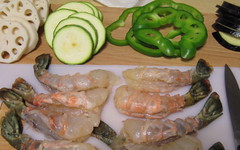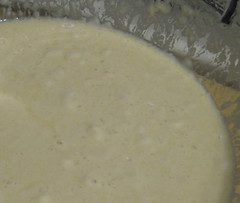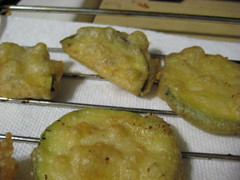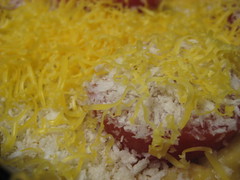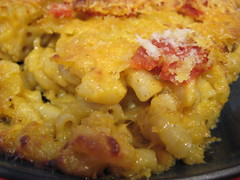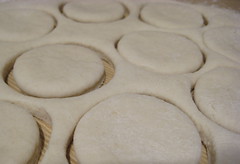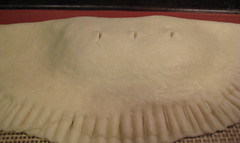Ok, so I was originally planning on doing a post about Mac & Cheese, but I happened to be going through my
Serious Eats feed over lunch on Monday and noticed this post by Ed Levine:
Trichinosis in Free-Range Pigs: Cause for Concern, or Sloppy Editing and Writing?. It refers to an article in the NYT Op-Ed section last thursday (the 9th) by James McWilliams that you can find
here. The McWilliams piece itself covers the results of study recently published in the journal
Foodborne Pathogens and Disease. The research article, titled
Seroprevalence of Trichinella, Toxoplasma, and Salmonella in Antimicrobial-Free and Conventional Swine Production Systems by Gebreyes et al. is currently freely available to anyone from the journal's website.
Now that I've gone through all that, I'll get to why I felt compelled to write this. To summarize, in reverse: the Geberney paper reported that pigs raised conventionally (i.e. in confinement pens) had lower exposure to potential human pathogens (including
Trichinella spiralis, the parasitic worm that causes trichinosis) than pigs raised in "free-range" systems. McWilliams took the stated results of the Gebreyes paper and repeated them to a much wider audience (the readership of the NYT is bigger that any scientific journal, sadly). He then used the results to put forth the position that the current rush by many "foodies" to free range animal husbandry can actually be hazardous to public health. Levine on Monday posted his own opinion (a re-buttal of sorts) stating that many of the conclusions McWilliams reaches about the hazards to public health are overstated and that his position is biased by his association with the pork industry. Unfortunately, the whole set of articles have serious flaws that need to be made clear before people rush to judgement. If you'll allow me the chance, I'm going to go through each article sequentially and try to give a balanced assessment of the strengths and weakness thereof.
I'll start with the Gebreyes paper as it somewhat started this whole mess (although to be fair, this has been a festering issue for both sides). Before actually getting into the meat of the paper, so to speak, I'm going to touch on what is probably the biggest issue many people have. The researchers, in this case 2 from Ohio State, 2 from Iowa State, and 1 from Wisconsin, were funded by a grant from the National Pork Board. So yes, it was "industry funded research". As far as most people are concerned, that means that any results that get published, no matter how good and/or bad they may be, are automatically biased
FOR whatever group funded the project. Speaking strictly as a graduate student, who's research is funded partially by industry, there is absolutely no inherent bias from that fact (yes, bias can occur, especially in the medical field, but its due to flaws in the researchers' ethics and not the money itself). Science is expensive, very very expensive. The US government simply can’t provide enough funding to keep all of us researchers busy, let alone happy. Thus, industry support is a very important part of the US research system, whether the general public likes it or not.
Now that I've just defended the funding of the research, I can address the quality... and to be honest, its just not very good. The paper itself has a number of errors in grammar and structure, which is never a good sign and reflects not only on the quality of the research but also the people who were supposed to properly review it. The researchers took blood samples from pigs raised under conventional or free range systems and analyzed them for anti-bodies to three primary pathogens. Unfortunately the number of pigs was not the same for each system or each location, which means the statistical analysis gets complicated if you do it properly. Unfortunately, as they have it written, I can only assume it wasn't done well enough. Comparisons and conclusions are drawn on sample sizes that are too small or skewed. Ignoring their analyses and using my own, the results can be summed as such: pigs in Wisconsin raised in either system have a higher prevalence of
Salmonella exposure than those in North Carolina or Ohio,
Toxoplasma exposure is low in either system, and
Trichinella was only seen in 2 free range and no conventional pigs. My conclusions: fully funded (i.e. major USDA grant type) research should be conducted to examine if free range systems really do have higher rates of pathogen exposure than conventional systems. As bad as the paper is, the authors had the same conclusion: " The finding in this
preliminary study warrants the need for a robust epidemiologic study to determine the role of various production-associated risk factors in the two production systems on the safety and wholesomeness of pork products, particularly on the persistence of bacterial (Salmonella) and potential reemergence of parasitic (Trichinella and Toxoplasma) pathogens." (emphasis added)
So what did Mr. McWilliams take from the same research paper I just graciously summed up for you? The same skewed view that anyone would if they didn't actually think while they read the research. Mr. McWilliams firstly states that the pigs were infected with certain pathogens. This is simply wrong as Gebreyes et al. measured anti-bodies and not actual pathogen presence. Yes, anti-bodies are created to fight an infection, but they can also be present after an infection has cleared or due to exposure to similar but non-pathogenic agents. Secondly, Mr. McWilliams talks only in percentages. While percentages can be useful, they often disguise the true results because you don't know what the raw numbers are. To see what I mean, I refer you to these posts
here and
here. McWilliams says "The study,[...] discovered not only higher rates of salmonella in free-range pigs (54 percent versus 39 percent) but also greater levels of the pathogen toxoplasma (6.8 percent versus 1.1 percent)". Unfortunately the true results are that
Salmonella exposure was observed in less than 30% of all pigs sampled, and depending on which state they were from the level was actually
higher in the conventionally raised pigs. The biggest issue of contention though arises not from his blindly trusting the researchers but from his misuse of their data to support his own agenda.
That agenda is to attack those who attack conventional animal husbandry. By alluding to rats and other potentially disturbing imagery, McWilliams manages to distract from the validity of his main argument and instead polarize the reader for or against him. The main argument, that free range animals face the risk of higher exposure to disease and thus can represent a higher risk to public health is absolutely correct. One of the primary reasons the pork industry embraced confined production was to minimize potential pathogen exposure, especially for
Trichinella. While many free range advocates (of which Ed Levine is one) state that this in fact increases the spread of pathogens amongst the herd (as evidenced by the necessity to feed sub-therapeutic levels of antibiotics to maintain animal health) its also greatly reduced the most risk of the most serious pork-associated pathogens to human health. Mr. McWilliams then goes on to suggest that "foodies" who desire free range pork because they believe it tastes better are deluding themselves because free range is an arbitrary middle ground between the standard confinement paradigm and true wild meat. Its a valid point, but he loses himself when he suggests that safe food and ethical production are diametrically opposed. The answer wouldn't be to give up pork completely as he suggest, but for scientists to conduct more research to find a better way. That way may cost more than conventional production, but may also cost less than current free range.
So what exactly did Mr. Levine do to warrant my writing up this long and involved post? Quite honestly he read the McWilliams piece and over-reacted, and like many a blogger, wrote up a post vehemently rebutting McWilliams. Now, that in and of itself isn't a bad thing (
its sort of what blogs are for right?), but Levine makes some serious misrepresentations in his post in order to refute the misrepresentations in the McWilliams piece. To start with, Mr. Levine states that his initial reaction to reading that pigs may still harbor
Trichinella was that he was possibly misinforming others about the possible danger that undercooked pork poses. He then talks to a free range pig producer (Levine refers to them as "designer pigs", by which he really means one of the heritage/old-world breeds that are generally only raised in small groups, often but not always as free range) and concludes that not only is McWilliams wrong but that he was right all along about the limited danger of trichinosis. To support his claim, he cites the National Pork Board's website (remember that they're supposedly evil by the way) to state that
Trichinella is killed at temperatures above 137F. Thats true. But it leaves open the chance some bacterial pathogens won't be killed. What's worse though is that free range production, while not entirely new, provides only a small fraction of the total demand for pork. This means that the opportunity for infection is currently very small, but could grow if production/consumption increases high enough.
The biggest misrepresentation in Levine's piece though is this quotation of Jennifer Small from
Flying Pigs Farms: "Confined pigs need huge doses of antibiotics, more than humans are ever given, and the diseases we can get from ingesting too much of those antibiotics are much scarier than trichinosis." While its true that the overuse of antibiotics in animal industry is a bad thing, you absolutely
DO NOT ingest the antibiotics fed to the animal itself. Furthermore, any "disease" that could occur would be a simple chemical imbalance and not an incurable parasitic infection. I understand, and partly agree with those who wish to lessen or eliminate sub-therapeutic feeding of antibiotics in animal production, but to suggest that they can cause illness in humans is being just as alarmist as Levine says McWilliams is about trichinosis.
I hope this write up was worth not only my time and effort in writing it, but also your own in reading it. The issue of "ethical" animal production is a complex and emotional mess. Supporters of any side of the debate (yes, there's more than two sides, as there rightly should be) often have strong biases and prejudices for and against production system X vs. Y. Unfortunately, this often causes the real underlying "facts" to be manipulated and/or ignored. I tried to give you those underlying facts so you can now make an informed decision about whether or not free range pork poses a higher public safety risk than conventionally raised.
As a result of doing this post I'm contemplating possibly doing one next month on industrial agriculture vs. organic. If you absolutely hated this one and would rather I stick to recipes, let me know. If you loved it and have other topics you think I should write on, let me know. This blog is a dictatorial republic (everyone gets a say but ultimately its my call...) so let me know what you want more of and/or less of.
Cheers,
Mike

